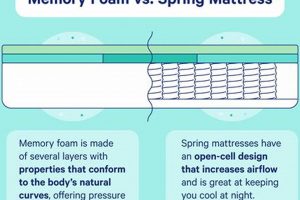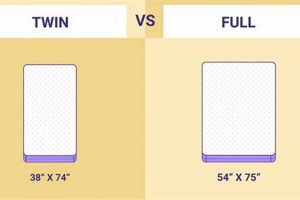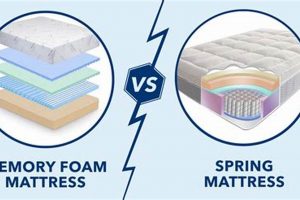The firmness level of a mattress significantly impacts the quality of sleep. A surface offering substantial resistance to pressure is categorized as firm, while one that yields readily and provides a sinking sensation is described as plush. The choice between these two relates directly to individual comfort preferences and physical needs. For instance, individuals who sleep on their back or stomach may find greater support in a firmer option, whereas those who prefer sleeping on their side may benefit from the pressure relief offered by a softer, more plush surface.
Selecting the appropriate level of support is crucial for maintaining spinal alignment and alleviating pressure points. Historically, mattress construction focused predominantly on firmer options; however, advancements in materials and manufacturing techniques have broadened the spectrum of available feels. This diversification addresses a wider range of consumer needs and preferences, contributing to improved sleep quality and overall well-being by catering to specific body types and sleeping positions.
Therefore, a detailed comparison of the characteristics associated with varying levels of surface give is essential. Factors to consider include the type of internal support core, the materials used in the comfort layers, and their impact on overall feel. The ensuing discussion explores these aspects, providing a framework for informed decision-making when selecting a sleep surface that best suits individual requirements.
Considerations for Optimal Sleep Surface Selection
Evaluating the suitability of a sleep surface requires careful consideration of individual physiological characteristics and preferred sleep positions. The following guidelines offer a framework for making an informed choice.
Tip 1: Assess Spinal Alignment Needs: Individuals should evaluate their typical sleep posture. Back and stomach sleepers often require a firmer surface to prevent excessive sinking, which can lead to spinal misalignment. Side sleepers generally benefit from a plusher surface that conforms to the body’s contours, alleviating pressure on the shoulders and hips.
Tip 2: Factor in Body Weight: Body weight significantly influences the degree to which a sleep surface compresses. Individuals with higher body weights may require a firmer option to ensure adequate support and prevent the sensation of “bottoming out.” Lighter individuals may find that a plusher surface provides sufficient support and comfort.
Tip 3: Account for Pressure Point Sensitivity: Individuals experiencing joint pain or pressure point sensitivity should prioritize pressure relief. Plusher surfaces, often incorporating materials like memory foam or latex, can distribute weight more evenly, reducing localized pressure and discomfort.
Tip 4: Investigate Core Construction: The internal support core plays a critical role in determining overall firmness and longevity. Innerspring systems typically offer greater firmness, while pocketed coil systems may provide more targeted support and reduced motion transfer. Foam cores offer varying degrees of firmness depending on density and composition.
Tip 5: Evaluate Comfort Layer Materials: The composition of the comfort layersthe materials directly beneath the sleep surfacecontributes significantly to the overall feel. Memory foam provides conforming support, latex offers resilience and responsiveness, and polyfoam provides a more general cushioning effect. Consider material properties in relation to desired comfort and support characteristics.
Tip 6: Trial Before Purchase: Whenever possible, test potential options in person. Spend at least 10-15 minutes lying on each choice in your typical sleeping position to assess comfort and support. Many retailers offer trial periods, allowing for further evaluation at home.
Tip 7: Consider Partner Preferences: If sharing a bed, compromise is often necessary. Explore options with split firmness levels or designs that minimize motion transfer to accommodate differing preferences.
Careful consideration of these guidelines, combined with a thorough understanding of individual needs, can lead to a more satisfying sleep experience. The selection process should prioritize spinal alignment, pressure relief, and overall comfort to promote restful and restorative sleep.
These tips provide a basis for informed decision-making. The concluding section summarizes key considerations and offers final recommendations.
1. Support and alignment
The primary function of any sleep surface is to provide adequate support, thereby maintaining proper spinal alignment throughout the sleep cycle. The degree of firmness or plushness directly impacts the ability of a mattress to achieve this objective. Insufficient support, often associated with overly plush models, allows the body to sink excessively, leading to spinal misalignment and potential musculoskeletal discomfort. Conversely, an excessively firm surface may not conform adequately to the body’s natural curves, resulting in pressure points and compromised alignment, particularly in the shoulder and hip regions for side sleepers.
Consider, for example, an individual with a history of lower back pain. A mattress that is too plush may exacerbate the condition by failing to provide sufficient lumbar support, causing the spine to curve unnaturally. This can result in muscle strain and increased pain levels. Conversely, a very firm mattress might place undue pressure on the sacrum and shoulders, leading to discomfort and disrupted sleep. The optimal selection depends on individual anatomy, sleeping position, and pre-existing conditions. A neutral spinal alignment, as observed when standing with correct posture, should be approximated when lying on the sleep surface.
In summary, the relationship between support, alignment, and mattress firmness is critical for promoting restful and restorative sleep. A balance between conformity and support is necessary to accommodate individual needs and prevent musculoskeletal issues. The practical significance of understanding this connection lies in the ability to make informed decisions when selecting a mattress, ultimately contributing to improved sleep quality and overall well-being. The choice is not simply a matter of personal preference, but a decision with direct implications for physical health.
2. Pressure point relief
Pressure point relief is a paramount consideration in sleep surface selection, intrinsically linked to the firmness level. The capacity of a mattress to alleviate concentrated pressure significantly influences sleep quality, particularly for individuals with musculoskeletal conditions or heightened sensitivity.
- Surface Conformity and Weight Distribution
The ability of a sleep surface to conform to the body’s contours is crucial for distributing weight evenly. A plusher surface, characterized by materials like memory foam or latex, yields more readily to pressure, minimizing concentrated stress on prominent areas such as the shoulders, hips, and knees. This redistribution prevents the localized constriction of blood vessels, promoting healthy circulation and reducing discomfort. A firmer surface, in contrast, may not provide adequate conformity, leading to increased pressure on these points and potential sleep disruption.
- Material Properties and Responsiveness
Different materials exhibit varying degrees of responsiveness, directly affecting pressure relief. Memory foam, for instance, possesses viscoelastic properties, conforming slowly to the body and retaining its shape, thereby providing sustained pressure relief. Latex, while also conforming, exhibits greater responsiveness, quickly adapting to changes in body position. Innerspring systems, particularly those with individually pocketed coils, can offer targeted pressure relief by isolating motion and conforming to specific body areas. The selection of appropriate materials is critical for optimizing pressure relief based on individual needs and preferences.
- Sleeping Position and Pressure Concentration
Sleeping position significantly influences the location and intensity of pressure points. Side sleepers, for example, tend to experience higher pressure concentrations on the shoulders and hips due to the body’s narrower profile in this position. A plusher surface is often recommended for side sleepers to provide adequate cushioning and prevent pressure buildup. Back sleepers, on the other hand, may benefit from a firmer surface that provides more uniform support and prevents excessive sinking, which can compromise spinal alignment. Stomach sleepers typically require a firmer surface to minimize pressure on the abdominal area and prevent lower back strain.
- Impact on Circulation and Sleep Quality
Inadequate pressure relief can impede circulation, leading to discomfort, restlessness, and frequent awakenings throughout the night. Compression of blood vessels restricts blood flow to tissues, potentially causing pain and tingling sensations. Prolonged pressure on bony prominences can also contribute to the development of pressure ulcers, particularly in individuals with limited mobility. By effectively distributing weight and minimizing pressure points, an appropriately selected sleep surface promotes healthy circulation, reduces discomfort, and improves overall sleep quality.
Ultimately, the optimal choice hinges on a careful evaluation of individual needs, preferences, and physiological characteristics. The interplay between firmness level, material properties, and sleeping position dictates the extent to which a mattress effectively alleviates pressure points, contributing to a more restful and restorative sleep experience. Considering these factors is crucial for minimizing discomfort and maximizing sleep quality.
3. Personal sleep position
Personal sleep position exerts a direct influence on the optimal selection between firmness levels. The primary cause stems from how different positions distribute body weight and pressure across the sleep surface. For example, individuals who predominantly sleep on their side experience a concentration of pressure on the shoulders and hips. This necessitates a plusher surface that allows these areas to sink slightly, promoting spinal alignment and mitigating discomfort. Conversely, sleeping on one’s stomach distributes weight more evenly across the torso. In this case, a firmer mattress is generally recommended to prevent excessive sinking, which can lead to hyperextension of the spine and subsequent lower back pain. Therefore, sleep position is a crucial component in determining the appropriate level of support offered by a mattress.
Consider an individual who consistently sleeps on their back. A mattress that is too plush may allow the pelvis to sink too deeply, resulting in a “hammocking” effect that compromises spinal alignment. This can lead to lower back pain and stiffness. In contrast, a firmer mattress provides more uniform support, preventing excessive sinking and maintaining the natural curvature of the spine. Similarly, a side sleeper on a firm mattress might experience significant pressure on the shoulder and hip, leading to discomfort and potential numbness or tingling in the extremities. A real-life example would be someone who switches from a stomach-sleeping position on a firm mattress to a side-sleeping position and finds the same mattress now causes significant shoulder pain due to lack of contouring. The practical significance of this understanding lies in the ability to proactively select a sleep surface that accommodates individual needs and minimizes the risk of musculoskeletal issues.
In summary, the interplay between preferred sleep position and firmness level is critical for achieving optimal spinal alignment and pressure relief. Failure to account for sleep position can result in discomfort, pain, and disrupted sleep. Selecting a mattress that complements individual sleep habits is not merely a matter of personal preference, but a fundamental aspect of promoting physical well-being. While other factors such as body weight and individual sensitivities also play a role, sleep position remains a primary determinant in the firm versus plush decision.
4. Body weight influence
Body weight exerts a substantial influence on the perceived firmness and support characteristics of a sleep surface. A heavier individual will compress the materials of a mattress to a greater extent than a lighter person. Consequently, a mattress that feels firm to someone of lower weight may feel considerably softer to someone of higher weight. This differential compression affects spinal alignment, pressure point relief, and overall comfort. For example, a person weighing 250 pounds may find a mattress marketed as “medium-firm” to be adequately supportive, while a person weighing 150 pounds may perceive the same mattress as excessively firm and lacking in pressure relief. The correct selection is thus contingent upon accounting for the individual’s mass and its interaction with the mattress’s construction and materials. Inadequate consideration of weight can lead to either insufficient support, resulting in spinal misalignment and back pain, or inadequate pressure relief, causing discomfort and disrupted sleep.
Practical applications of this understanding are evident in mattress design and marketing. Manufacturers often specify weight recommendations for their products, indicating the range of body weights for which the mattress is expected to provide optimal performance. Similarly, retailers often provide guidance to customers based on their body weight, suggesting mattress models that are likely to offer appropriate support and comfort. Consider the case of an individual with a body mass index classified as obese. This person would likely benefit from a mattress with a high coil count or a dense foam core, providing enhanced support and preventing excessive sinkage. The materials used in the comfort layers also play a crucial role. High-density foams and latex are generally more resistant to compression than lower-density foams, making them suitable for heavier individuals. Failure to accommodate these factors can lead to premature wear and tear of the mattress, as well as compromised sleep quality.
In summary, body weight is a critical determinant in the selection of an appropriate sleep surface. Its influence on mattress compression directly affects spinal alignment, pressure relief, and overall comfort. Manufacturers and retailers are increasingly incorporating weight considerations into their product design and sales processes. Individuals should be aware of the impact of their own body weight on mattress performance and seek guidance accordingly. While individual preferences and other factors also play a role, body weight remains a primary consideration in the firm versus plush decision, contributing significantly to the long-term satisfaction and health benefits derived from a well-chosen sleep surface.
5. Material composition impact
The material composition of a sleep surface fundamentally dictates its firmness or plushness, and consequently, its suitability for individual needs. The interplay between core materials and comfort layers defines the overall feel and performance of the mattress.
- Core Material Density and Support
The density of the core material, whether it be innerspring, foam, or hybrid, is a primary determinant of support. High-density foam cores, for instance, resist compression more effectively than low-density foams, contributing to a firmer feel. Similarly, innerspring systems with a higher coil count and thicker gauge wires provide greater resistance to sinking, resulting in enhanced support. A real-world example involves comparing two mattresses with identical comfort layers but differing core densities. The mattress with the higher-density core will consistently provide greater support and a firmer feel, particularly for individuals with higher body weights.
- Comfort Layer Materials and Pressure Relief
The materials used in the comfort layers directly influence the level of pressure relief. Memory foam, known for its viscoelastic properties, conforms closely to the body’s contours, distributing weight and reducing pressure points. Latex, available in both Dunlop and Talalay forms, offers a responsive and buoyant feel, providing both comfort and support. Polyfoam, often used as a transition layer, offers varying degrees of cushioning depending on its density. Consider the case of a mattress incorporating a thick layer of memory foam over a firm innerspring core. The memory foam will provide significant pressure relief, while the innerspring core will offer underlying support. This combination can be suitable for individuals seeking a balance between comfort and support.
- Material Resilience and Longevity
The resilience of the materials used in a mattress affects its long-term durability and performance. High-quality materials, such as high-density foams and natural latex, tend to maintain their shape and support characteristics over time, resisting sagging and compression. Lower-quality materials, such as low-density polyfoams, are more prone to degradation, leading to a loss of support and comfort. For example, a mattress constructed with durable materials is likely to maintain its intended firmness level for a longer period, whereas a mattress constructed with less resilient materials may become softer and less supportive over time.
- Material Breathability and Temperature Regulation
The breathability of the materials influences temperature regulation during sleep. Materials like open-cell foams, latex, and cotton promote airflow, dissipating heat and moisture. Closed-cell foams, such as traditional memory foam, tend to retain heat, potentially leading to discomfort. Consider a mattress incorporating a layer of gel-infused memory foam. The gel infusion is intended to improve heat dissipation, but the overall breathability may still be limited compared to a mattress constructed with more breathable materials, such as latex or cotton.
In summary, the material composition of a mattress is a critical determinant of its firmness, support, pressure relief, durability, and temperature regulation. The interplay between core materials and comfort layers dictates the overall feel and performance of the sleep surface. A thorough understanding of material properties is essential for making an informed decision when selecting a mattress that meets individual needs and preferences. The objective is not merely to choose between firm or plush, but to select materials that provide the optimal combination of support, comfort, and longevity.
Frequently Asked Questions
The following addresses commonly asked questions related to mattress firmness levels, providing clarity on key considerations for optimal sleep.
Question 1: What are the primary differences between a firm and a plush mattress?
A firm mattress offers greater resistance to pressure, providing minimal give and substantial support. A plush mattress, conversely, yields more readily, conforming to the body’s contours and offering enhanced pressure relief.
Question 2: Is a firm mattress always better for back pain?
Not necessarily. While a firm mattress can provide support and prevent spinal misalignment, it may not be suitable for all individuals with back pain. A medium-firm or even a plush mattress may be preferable for side sleepers or those with pressure-sensitive conditions.
Question 3: Does body weight influence the choice between firm and plush?
Yes. Individuals with higher body weights tend to compress mattress materials to a greater extent. A firmer mattress may be necessary to provide adequate support and prevent excessive sinking. Lighter individuals may find a plush mattress sufficiently supportive.
Question 4: How does sleep position factor into the decision?
Sleep position significantly influences the optimal firmness level. Side sleepers typically benefit from a plush mattress to alleviate pressure on the shoulders and hips. Back and stomach sleepers generally require a firmer mattress to maintain spinal alignment.
Question 5: Are there specific materials that contribute to a firmer or plusher feel?
Yes. High-density foams and innerspring systems with a higher coil count tend to create a firmer feel. Memory foam and latex comfort layers contribute to a plusher, more conforming feel.
Question 6: How can the suitability of a mattress be assessed before purchase?
Whenever possible, test the mattress in person, spending at least 10-15 minutes lying on it in typical sleep positions. Evaluate spinal alignment, pressure relief, and overall comfort. Many retailers offer trial periods, allowing for at-home assessment.
Selecting the appropriate firmness level necessitates a careful consideration of individual physiological characteristics, sleep preferences, and body weight. These factors collectively determine the optimal sleep surface for promoting restful and restorative sleep.
The following segment provides guidance on the impact of sleeping position in determining the best mattress.
Firm vs Plush Mattress
The preceding exploration underscores the critical relationship between mattress firmness and individual physiological needs. The selection between a firm vs plush mattress is not merely a matter of subjective preference but a decision with direct implications for spinal alignment, pressure relief, and overall sleep quality. Key determinants include body weight, sleep position, and pre-existing musculoskeletal conditions. Ignoring these factors can lead to discomfort, disrupted sleep patterns, and potential long-term health consequences.
Ultimately, the pursuit of optimal sleep necessitates a considered assessment of personal requirements and a thorough understanding of the characteristics associated with varying levels of mattress firmness. While trends and marketing claims may influence perception, a rational, evidence-based approach is paramount. A well-informed decision, tailored to individual needs, represents a critical investment in long-term health and well-being, ensuring restorative sleep and promoting overall quality of life.







